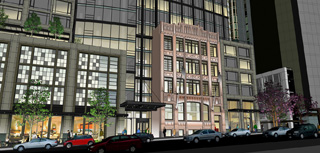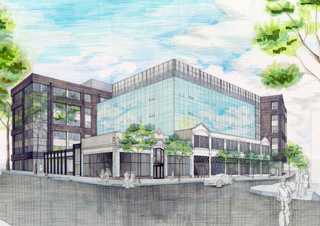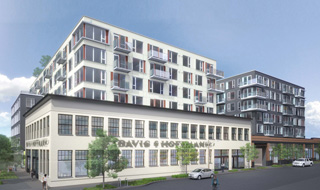|
Subscribe / Renew |
|
|
Contact Us |
|
| ► Subscribe to our Free Weekly Newsletter | |
| home | Welcome, sign in or click here to subscribe. | login |
Architecture & Engineering
| |
February 11, 2013
Keeping up a facade can help developers add height, and hold onto a bit of the past
Journal Construction Editor
Eyebrows were raised recently when crews tore down the frame of the Cosmopolitan Motors Building at the corner of Eighth Avenue and Lenora Street to make room for a 39-story apartment tower.
Some people thought the 1925-vintage facade would be saved as part of the new development, but the beaux arts style building designed by Earl Roberts will be used as aggregate for concrete.
“Some developers choose to keep the facades voluntarily, but most developers defer to the landmarks board,” said Blaine Weber of Weber Thompson, the architect for the apartment tower. “The ultimate authority or arbiter is the landmarks board.”
In the case of the Cosmo building, the Seattle Landmark Preservation Board determined it wasn't historically significant.
Parts of other buildings around town have been saved, thanks to the preservation board and a handful of developers.
Another project designed by Weber Thompson but currently on hold would save the facade of the 1915 Terminal Sales Annex at Second Avenue and Virginia Street. The annex was designed by Carl F. Gould, who founded the University of Washington's Architecture Department and designed 46 UW buildings with the firm Bebb + Gould.
The project developer, Columbia West Properties, wants to use the facade of the annex in the base of a 38-story building that could have 190 condos, 154 hotel rooms and 6,100 square feet of retail.
The project was originally submitted to the city for early design guidance in late 2007 and the latest activity was a land-use decision in December 2008.
In South Lake Union, Vulcan Real Estate kept an entire brick building in the heart of Amazon.com's campus, and filled the shell with three Tom Douglas restaurants. Ting Momo, one of them, has since closed, according to the website yelp.
Also in South Lake Union, Touchstone Corp. plans to incorporate the 1927 Troy Laundry and 1925 Boren Investment buildings into a two-tower, 800,000-square-foot office project on the block bordered by Harrison and Thomas streets and Boren and Fairview avenues North. Both buildings are landmarked.
A representative from Perkins + Will, the architect, didn't return a call. Late last year Touchstone submitted a land-use application for the project and it is now in design review.
A-P Hurd, Touchstone's vice president of development, said the project will enrich the neighborhood. “We're really excited about how the old buildings and new buildings will integrate together.”
Another old laundry is being saved nearby at Yale Avenue North and Republican Street. Vulcan is reusing the historic Supply Laundry for the retail component of a 278-unit apartment complex called Stack House. Runberg Architecture Group is the architect and Exxel Pacific is the general contractor.
The complex is set to open this fall.
A more tricky preservation is in store for the Allen Institute for Brain Science on the block bounded by Westlake and Ninth avenues North and Broad and Mercer streets. The 250,000-square-foot research center will incorporate elements from the Pacific McKay and Ford McKay dealerships that were demolished to make way for the Mercer Corridor project. Terra cotta facades from the dealerships were put into storage and will be part of the Allen Institute.
The Vulcan project is expected to begin construction in October, with GLY as general contractor and Perkins + Will as architect.
‘Character structures'
“Twenty to 30 years ago there wasn't much of an effort to save buildings,” Weber said.
But that's changing, thanks in part to new rules passed a few years ago by the city. Developers in the Pike-Pine corridor can build larger projects by preserving the facades of “character structures” that are at least 75 years old.
Alliance Realty Partners of Phoenix is proposing a 75-foot-tall apartment complex on East Union Street between 10th and 11th avenues, on a site zoned for 65-foot buildings. The city is considering the taller building because it would preserve two facades — the Davis Hoffman building at 10th and Union, and the old Engler Car Repair at 11th and Union — and modify them for street-level retail. Both were described as reflecting the area's auto row past.
Alliance also plans to save the facade of a third building on the site, adjacent to Engler on 11th. In documents submitted to the city, Alliance said there will be significant expense in saving the third facade and no zoning incentives, but “we believe this is the best course for our project and for the neighborhood.”
Ankrom Moison Associated Architects of Seattle is designing the project, which has 244 units above 14,000 square feet of retail. It is under review with the city and an Ankrom Moison representative said the firm had no comment.
Also on Capitol Hill, Wolff Co. and O&S Partners are each building apartment projects on the block bounded by Pine, Pike, Boylston and Harvard. Both developers will save old facades to get more units.
Weber Thompson designed the seven-story Wolff project with 270 units over 6,000 square feet of retail. The 1926 brick-framed building on Pike Street was used as a BMW showroom and parts of it will be incorporated into the project. The old showroom has a concave face that allows for a public plaza and a sweeping entrance to the retail.
Wolff is a Scottsdale, Ariz.-based real estate equity firm.
Denny Onslow of O&S Partners said he wants to keep the neighborhood character by using brick walls facing Harvard and Pine in his new building. He also wants to reuse old windows from the 1920 building.
Onslow and business partner Jim Sepic plan to start construction in August.
Extra costs
Construction could pose some challenges for O&S because old facades are not as structurally sound as new construction. Onslow said they will build a structure behind the facade to brace it during construction, which includes digging an underground garage. That will add costs, but getting an extra floor should offset that, he said.
“I think it's a good balance overall,” Onslow said. “It's also good for the neighborhood.”
Weber said saving a facade can add $1 million to $2 million to the cost of a project.
Murray Franklyn spent about $3 million to integrate the terra-cotta facade of the 1906 Crystal Pool into its Cristalla condominium tower, which Weber Thompson also designed.
Weber said that required constructing an 8-inch-thick concrete wall that was pinned to the existing facade with epoxied stainless steel rods. The entire facade was supported with steel rakers and bracing that remained in place until the high-rise superstructure was complete.
Murray Franklyn preserved the old structure voluntarily, as there was no landmark status for the building.
Weber said the old facade had one problem: not enough depth. “You need to preserve enough of the depth so it reads as a structure not as an applied facade,” he said.
Last year, the DJC wrote about Seattle councilmembers Tom Rasmussen and Sally Clark's concerns that a wave of new development could overwhelm the character of Pike-Pine. They asked the East Design Review Board to considering proposals carefully.
“There's often that pressure from the developer to get it permitted and under way,” Rasmussen said at the time.
Onslow said the landmark board can be difficult at times because it is so precise about what it wants. He said the Pike-Pine corridor rule is easier for developers because it focuses on keeping the design intent.
“It's one of the better done formulas developed by the city,” he said.
Benjamin Minnick can be
reached by email or by phone
at (206) 622-8272.





